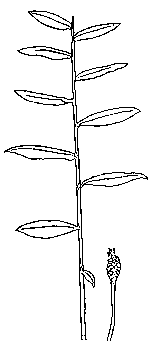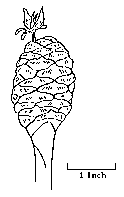Canoe Plants of Ancient Hawai`i Home - Intro - Contents - Bibliography - Links - Credits `Ape - `Awa -`Awapuhi -Hau -Ipu -Kalo -Kamani -Ki -Ko -Kou -Kukui -Mai`a Milo -Niu -Noni -`Ohe -`Ohi`a `Ai -`Olena -Olona -Pia -`Uala -Uhi -`Ulu -Wauke |
Canoe Plants of Ancient Hawai`i Home - Intro - Contents - Bibliography - Links - Credits `Ape - `Awa -`Awapuhi -Hau -Ipu -Kalo -Kamani -Ki -Ko -Kou -Kukui -Mai`a Milo -Niu -Noni -`Ohe -`Ohi`a `Ai -`Olena -Olona -Pia -`Uala -Uhi -`Ulu -Wauke |
 What a glorious exotic family are the tropical `awapuhi! All the members of the `awapuhi `ohana are known for their pungent pleasant aroma and/or their beauty.
What a glorious exotic family are the tropical `awapuhi! All the members of the `awapuhi `ohana are known for their pungent pleasant aroma and/or their beauty.Summertime brings us the blooms and sweet fragrance of the white ginger, `awapuhi ke`oke`o, and the yellow ginger, `awapuhi melemele. Throughout the seasons of the year we can appreciate the kahili ginger, crepe ginger, the red ginger called `awapuhi `ula`ula, and the edible root ginger, `awapuhi`ai, also called `awapuhi pake, or commercial Chinese or Jamaican ginger.
Lastly, in summertime, are to be found abundant stands of `awapuhi kuahiwi, native wild shampoo ginger, sometimes called opuhi, with the botanical name of Zingiber zerumbet.
This plant originated in India, was distributed eastward through Polynesia and introduced to these islands in the canoes of early settlers. The leaves and leaf stalks, which are also fragrant, were used in baking in the imu, underground oven, to enhance the flavor of pork and fish as they cooked. Traditionally, the aromatic underground roots/rhizomes were sliced, dried and pounded to a powder, then added to the folds of stored kapa/tapa cloth. The spicy-smelling fresh roots were pounded and used as medicine for indigestion and other ailments. The roots can be stored in a cool, dark place to keep for use when needed. In traditional use, the root was ground in a stone mortar with a stone pestle, was mixed with a ripe noni fruit and then used to treat severe sprains. The pulp was placed in a cloth and loosely bound around the injured area. The dressing was changed daily until the sprain healed. The warmth of the afternoon sun could also be beneficial to the injured part.
For a toothache or a cavity, the cooked and softened `awapuhi root was pressed into the hollow and left for as long as was needed.
To ease a stomachache, the ground and strained root material is mixed with water and drunk. Similarly, `awapuhi pake (Zingiber officinale) is widely cultivated and eaten, or made into a tea for indigestion as well as increased circulation of the blood and an increased sense of well-being.
The `awapuhi is said to be one of the kinolau, multiple forms, of the Hawaii deity Kane.
 Finally, perhaps the most common use of `awapuhi kuahiwi is as a shampoo and conditioner for the hair. The clear slimy and sudsy juice present in the mature flower heads is excellent for softening and brings shine to the hair. It can be left in the hair or rinsed out, as you wish. Often we pick or cut the flowerheads of this plant in the forest, as we approach a pool or waterfall for a refreshing summer bath, leave the flowers atop a nearby rock, and then squeeze the sweet juices into our hair and over our bodies when our swim is completed. The sudsy juice is excellent for massage, too, either by the pool or at home.
Finally, perhaps the most common use of `awapuhi kuahiwi is as a shampoo and conditioner for the hair. The clear slimy and sudsy juice present in the mature flower heads is excellent for softening and brings shine to the hair. It can be left in the hair or rinsed out, as you wish. Often we pick or cut the flowerheads of this plant in the forest, as we approach a pool or waterfall for a refreshing summer bath, leave the flowers atop a nearby rock, and then squeeze the sweet juices into our hair and over our bodies when our swim is completed. The sudsy juice is excellent for massage, too, either by the pool or at home.
This plant can easily be cultivated in home gardens. A patch in my Hana garden kept me supplied with hair conditioner and body lotion during the summers. If you are considering growing it in your garden, be sure to allow a large area. The `awapuhi tend to form thick stands, following their large underground stems horizontally, just under the earth's surface. `Awapuhi kuahiwi is best propagated in autumn by planting a piece of rootstock with buds, in a shallow trench of broken and composted soil.
`Awapuhi kuahiwi is a perennial, so from autumn until spring it becomes dormant above ground as the leaf stalks die away. In the spring the plant springs up anew. The 10-12 blade-shaped leaves grow to 6-8 inches on the approximately 3 foot long stalks. The leaves grow in an alternate arrangement on the upright, thin, fleshy stalk. Among the leaf stalks, the conical or club-shaped flower heads burst forth upon their separate and shorter stalks. These appear in the summer, after the leaf stalks have been growing for awhile.
As the 2-3 inch long bracts/flower heads mature, they gradually fill with an aromatic, slimy liquid. The heads are reddish-green with overlapping scales, producing small yellowish-white flowers that poke out a few at a time. These tiny flowers are similar in fragrance to the larger and more delicate butterfly-like yellow and white ginger blossoms, growing from the base toward the head. The flower stalks usually remain beneath the leaf stalks, enjoying the moist shade and warmth provided. This plant grows abundantly in areas where `ulu, kukui and `ohi`a `ai all thrive, often near or upon abandoned kalo terraces. `Awapuhi kuahiwi grows wild in patches at low altitudes in the open damp forest. The juice can be used to quench thirst when out walking in the forest, and makes a lovely lunch when combined with a few mountain apples.
Shampoo ginger has a history of versatility
Honolulu Advertiser, June 24, 2005
![]()
| Canoe Plants of Ancient Hawai`i Home Intro - Contents - Bibliography - Links - Credits `Ape -`Awa -`Awapuhi - Hau -Ipu -Kalo -Kamani -Ki -Ko -Kou -Kukui -Mai`a |